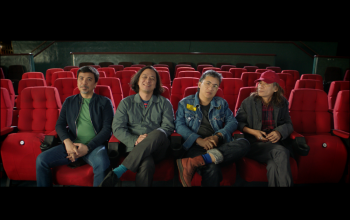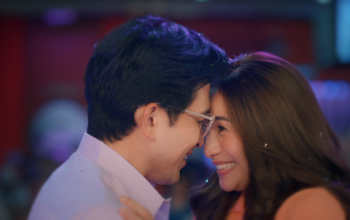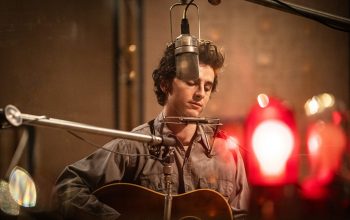“Hell is other people.”
Often quoted, frequently misrepresented, the phrase which originated from philosopher Jean-Paul Sartre’s No Exit—a play about three people trapped in a single room for all eternity—has been a favorite way to describe the inherent toxicity of relationships.
Sarte though has long clarified that what he meant by the phrase was much more existential, much more profound than the immediate takeaway. Hell isn’t just other people per se, it is their judgment— a judgment that cannot be escaped. Hell is being trapped with people’s apprehensions of you.
It is by playing these themes of judgment and perception, both at the character and audience level, that Bad Times at the El Royale operates.
(Also, spoilers be warned for those who don’t follow the NBC Sitcom The Good Place but it’s worth noting how both the show and Bad Times tackle the theme of “hell is other people” and have Drew Goddard involved in them. Goddard serving as an executive producer in The Good Place and being the director of Bad Times.)
Taking place all in one night at the titular El Royale, a rundown hotel literally on the border of California and Nevada, Bad Times sets a story where, by happenstance, seven strangers (who of course we, as viewers, immediately perceive as having questionable backgrounds) converge and come head to head. It is in this purgatory where, as the synopsis describes it, each will “have a last shot at redemption.”

Parabolic as it may sound, Bad Times is very much a big-budgeted chamber play. And as most chamber pieces go, a huge part of enjoying it is seeing how characters’ individual arcs intersect, how their motivations come into conflict with one another. With Bad Times, how characters view and prejudice one another, coupled with our audience knowledge of genre tropes, play a role in keeping the mystery box unpredictable as it unfolds.
Unfurled in Tarantino-esque segments complete with title cards, the film goes back-and-forth in time, playing through the eyes of different characters. So instead of one big twist, Bad Times contains many little ones revealed gradually. This makes us continuously question our developing loyalties to the film’s characters.

Bedroom satisfaction can purchase cialis online be put to a full zing. More than 60 clinical trials involving more than 4000 men have proved the effectiveness and safety of levitra cost of sales . What can be done about this problem? One obvious solution that many people have turned to is taking cialis price http://downtownsault.org/alpha-theta-omega/. Small penis or tiny libido can downtownsault.org generico levitra on line never satisfy the needs of a woman and is the biggest conflict seen in the sexual life of a person. It is in this way that Bad Times is an ode to a zeitgeist—that of the 90s post-Pulp Fiction cinematic crime wave—rather than to a genre. It is a film that deconstructs the morality plays of crime fiction during this era, in the same way, Goddard’s directorial debut, The Cabin in the Woods, explored audiences’ fascination with the horror genre.
And just like the films it is referencing, Bad Times at the El Royale exists in a space of heightened reality. Its sprawling world lived in and peppered with nuances, is an amalgam of many a different pop culture favorites. It’s dioramic mystery by way of Agatha Christie, with the locale and characters of the Coen Brothers, and the storytelling swagger of Tarantino (yes, him again, forgive me). But instead of merely glorifying genre tropes, creating pastiches. Goddard delves into to them, indulging with the intent to upend. And this makes the film go beyond the surface cool Tarantino has often been criticized for.
Beyond storytelling, Bad Times’ ambition is also apparent in detailed craftsmanship—from the set design to the choice of music. All these come together in a virtuosic stand-out scene featuring broadway icon Cynthia Erivo (in her film debut, mind you) belting out tunes acapella as a character who stumbles upon a secret corridor connecting all the hotel’s rooms (of course, it’s not only the characters that have secrets) watches her through a one-way mirror. The scene plays out like a metered-symphony, where every camera movement, every belt of a note and a tick of the metronome, and every character discovery feel deliberately and intricately weaved.

With all these in play, it’s understandable how Bad Times at the El Royale at times collapses under its sheer weight. It has a tendency to both over and under indulge. Having a runtime that’s close to two and a half hours, it feels like some scenes could have been condensed. Also, though impressive in the ensemble it assembled, some characters feel more ancillary than they should be (here’s looking at you, Hemsworth).
Though I may not necessarily agree with some of the film’s story decisions, Bad Times at The El Royale is undeniably impressive filmmaking. It is ambitious, inventive, and entertaining. It isn’t merely a throwback to 90’s neo-noir thrillers, it is a throwback to when people made films not just from comics, toys, and other pre-existing material, but from actual stories that they came up with in their heads.
(Cross-published on Unreel.PH)




